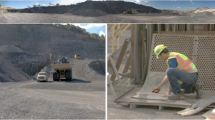Abstract
Effective training is a critical component in improving mineworkers’ ability to identify and assess hazards and ultimately reduce accidents and injuries. Previous research has identified the importance of context and cultural relevance as significant factors in the effectiveness of training. Research from adult education, social marketing, and public health education also suggest that the inclusion of a personal connection to training may improve communication. However, there is limited empirical knowledge about the effects of training content composition. Specifically, it is unclear how the inclusion of workers in training materials may affect how mineworkers’ perceive a hazard. The goal of this paper is to examine if the presence of workers in the context of hazards affects how mineworkers’ assess the risks. Researchers collected risk assessments from participants in the laboratory and during mandatory, annual refresher training. The results have implications for training material development and workplace examination timing.
Access this chapter
Tax calculation will be finalised at checkout
Purchases are for personal use only
Similar content being viewed by others
References
MSHA: Overview of Deaths in Metal and Nonmetal Mining from October 2013 to December 2016. Mine Safety and Health Administration (2017). http://MSHA.gov
Bahn, S.: Workplace hazard identification and management: the case of an underground mining operation. Saf. Sci. 57, 129–137 (2013)
Eiter, B.M., Helfrich, W., Hrica, J., Bellanca, J.L.: From the laboratory to the field: developing a portable workplace examination simulation tool. AHFE 2018. In: Cassenti, D. (ed.) Advances in Human Factors in Simulation and Modeling, AHFE 2018. Advances in Intelligent Systems and Computing, vol. 780. Springer, Cham (2019)
Hunter, D.R.: Risk Perception and Risk Tolerance in Aircraft Pilots (No. DOT/FAA/AM-02/17). Federal Aviation Administration, Washington, DC, Office of Aviation Medicine (2002)
Brewer, N.T., Chapman, G.B., Gibbons, F.X., Gerrard, M., McCaul, K.D., Weinstein, N.D.: Meta-analysis of the relationship between risk perception and health behavior: the example of vaccination. Health Psychol. 26(2), 136 (2007)
Brown, I.D., Groeger, J.A.: Risk perception and decision taking during the transition between novice and experienced driver status. Ergonomics 31(4), 585–597 (1988)
Perlman, A., Sacks, R., Barak, R.: Hazard recognition and risk perception in construction. Saf. Sci. 64, 22–31 (2014)
Eiter, B.M., Bellanca, J.L., Helfrich, W., Orr, T.J., Hrica, J., Macdonald, B., Navoyski, J.: Recognizing mine site hazards: identifying differences in hazard recognition ability for experienced and new mineworkers. In: Cassenti, D. (ed.) Advances in Human Factors in Simulation and Modeling, AHFE 2017. Advances in Intelligent Systems and Computing, vol. 591. Springer, Cham (2018)
Bellanca, J.L., Eiter, B.M., Hrica, J., Weston, T., Weston, R.: The effect of work experience on risk assessment skills. In: The Interservice/Industry Training, Simulation and Education Conference (I/ITSEC 2018), Orlando, FL, pp. 1–14 (2018)
Burke, M.J., Sarpy, S.A., Smith-Crowe, K., Chan-Serafin, S., Salvador, R.O., Islam, G.: Relative effectiveness of worker safety and health training methods. Am. J. Public Health 96(2), 315–324 (2006)
Aik, C.T., Tway, D.C.: Elements and principles of training as a performance improvement solution. Perform. Improv. 45(3), 28–32 (2006)
Wilkins, J.R.: Construction workers’ perceptions of health and safety training programmes. Constr. Manag. Econ. 29(10), 1017–1026 (2011)
Burke, L.A., Hutchins, H.M.: Training transfer: an integrative literature review. Hum. Resour. Dev. Rev. 6, 263–296 (2007)
Velada, R., Caetano, A., Michel, J.W., Lyons, B.D., Kavanagh, M.: The effects of training design, individual characteristics and work environment on transfer of training. Int. J. Train. Dev. 11, 282–294 (2007)
Grossman, R., Salas, E.: The transfer of training: what really matters. Int. J. Train. Dev. 15, 103–120 (2011)
Kraiger, K.: Perspectives on training and development. In: Handbook of Psychology, Industrial and Organizational Psychology, vol. 12, pp. 171–192. Wiley, Hoboken (2003)
Brunette, M.J.: Development of educational and training materials on safety and health. Fam. Community Health 28(3), 253–266 (2005)
Castro, F.G., Barrera Jr., M., Holleran Steiker, L.K.: Issues and challenges in the design of culturally adapted evidence-based interventions. Ann. Rev. Clin. Psychol. 6, 213–239 (2010)
Taylor, P.J., Russ-Eft, D.F., Chan, D.W.: A meta-analytic review of behavior modeling training. J. Appl. Psychol. 90(4), 692 (2005)
Weyman, A.K., Clarke, D.D.: Investigating the influence of organizational role on perceptions of risk in deep coal mines. J. Appl. Psychol. 88(3), 404 (2003)
Bellanca, J.L., Orr, T.J., Helfrich, W., Macdonald, B., Navoyski, J., Eiter, B.: Assessing hazard identification in surface stone mines in a virtual environment. In: Duffy, V. (ed.) Advances in Applied Digital Human Modeling and Simulation. Advances in Intelligent Systems and Computing, vol. 481. Springer, Cham (2017)
MSHA: Section 8: Coding Manual. Part 50 Data User’s Handbook. Mine Safety and Health Administration (2007). https://www.cdc.gov/niosh/mining/data/default.html
Wang, M.: Generalized estimating equations in longitudinal data analysis: a review and recent developments. Adv. Stat. 2014, 1–11 (2014)
Hsee, C.K., Hastie, R.: Decision and experience: why don’t we choose what makes us happy? Trends Cognit. Sci. 10(1), 31–37 (2006)
Ross, L., Greene, D., House, P.: The “false consensus effect”: an egocentric bias in social perception and attribution processes. J. Exp. Social Psychol. 13(3), 279–301 (1977)
Tversky, A., Kahneman, D.: Judgement under uncertainty: heuristics and biases. Science 185, 261–275 (1974)
Sicard, B., Jouve, E., Couderc, H., Blin, O.: Age and risk-taking in French naval crew. Aviat. Space Environ. Med. 72(1), 59–61 (2001)
Fries, J.F.: Aging, natural death, and the compression of morbidity. N. Engl. J. Med. 303(3), 130–135 (1980)
Author information
Authors and Affiliations
Corresponding author
Editor information
Editors and Affiliations
Rights and permissions
Copyright information
© 2020 This is a U.S. government work and not under copyright protection in the U.S.; foreign copyright protection may apply
About this paper
Cite this paper
Bellanca, J.L., Eiter, B., Hrica, J., Weston, R., Weston, T. (2020). Risk Perception with and Without Workers Present in Hazard Recognition Images. In: Cassenti, D. (eds) Advances in Human Factors and Simulation. AHFE 2019. Advances in Intelligent Systems and Computing, vol 958. Springer, Cham. https://doi.org/10.1007/978-3-030-20148-7_24
Download citation
DOI: https://doi.org/10.1007/978-3-030-20148-7_24
Published:
Publisher Name: Springer, Cham
Print ISBN: 978-3-030-20147-0
Online ISBN: 978-3-030-20148-7
eBook Packages: Intelligent Technologies and RoboticsIntelligent Technologies and Robotics (R0)




